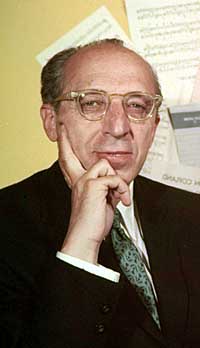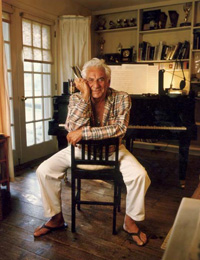| American Icons: Copland and Bernstein | ||||||||||
Fanfare for the Common Man During World War II, many conductors and music presenters commissioned composers to write works reflecting the spirit of the times and of a nation at war. In 1942 Eugene Goossens, conductor of the Cincinnati Orchestra, commissioned several American composers to write fanfares to commemorate various aspects of the nation at war. Copland’s Fanfare for the Common Man, was scored for brass and percussion; the composer wrote: “[It]...honors the man who did no deeds of heroism on the battlefield, but shared the labors, sorrows and hopes of those who strove for victory.” The work premiered in March 1943 and is the only one of the commissioned fanfares that has remained in the repertoire. It has seen duty at everything from national conventions to TV commercials, although without the funereal opening bass drum and timpani solos.  The juxtaposition of open intervals in the trumpet theme is one of Copland’s – and his imitators’ – hallmarks. The juxtaposition of open intervals in the trumpet theme is one of Copland’s – and his imitators’ – hallmarks.  Not wanting a good tune go to waste, Copland reused the Fanfare theme to great effect as the introduction to the finale of his Symphony No. 3. | ||||||||||
| Aaron Copland Four Dance Episodes from Rodeo During his long career, Aaron Copland composed in many diverse styles: scores for films (The Red Pony, Our Town, The Heiress); works incorporating jazz (Piano Concerto, Music for the Theater); and the serial (12-tone) technique (Piano Quartet, Piano Fantasy). But the works by which he is best known are his three American ballets: Billy the Kid (1938), Rodeo (1942) and Appalachian Spring (1943). In his early works from the 1920s, such as his Piano Concerto of 1926, Copland used a jazzy, hard-edged musical language, culminating in his highly dissonant Variations for Piano of 1930. The public refused to accept these works, especially the Piano Concerto: not since the premiere of Stravinsky’s The Rite of Spring in 1913 has a premiere garnered as much controversy, not to mention invective, as its premiere in January 1927 in Boston, under the baton of Serge Koussevitzky. By the mid-1930s Copland was beginning to feel “an increasing dissatisfaction with the relation of the music-loving public and the living composer.” In order to reach a wider audience he began to gradually simplify his style, and making it more accessible but without sacrificing artistic value. The first work in this more popular vein was El Salón Mexico (1936). He composed Rodeo for the dancer Agnes de Mille, who also wrote the scenario. She prefaced it with: “This is the story of The Taming of the Shrew – cowboy style.” Rodeo opened in October of that year and was a smashing success, garnering 79 performances by the end of the following year. In Rodeo, Copland uses authentic folk tunes and dance rhythms, although with modifications, evoking the scenes and sounds of the old West. Rodeo is the story of a cowgirl who has her eye on the head wrangler but is too much of a tomboy to attract him. The Orchestral Suite of four dance episodes, including all but five minutes of the original ballet, followed a year later. As he did with his other ballets, Copland enhanced the orchestration for the suite. A common feature to all the movements is the extended rhythmic lead-ins to the themes, or vamping.  The Suite opens with “Buckaroo Holiday.” The Cowgirl practices her limited riding skills in the corral together with the cowboys, but they pay no attention to her. The section is episodic, starting off with a festive theme.  A slower, more tentative halting melody portrays the Cowgirl. A slower, more tentative halting melody portrays the Cowgirl.  In this section Copland uses two folk tunes, "If He Be a Buckaroo by His Trade," In this section Copland uses two folk tunes, "If He Be a Buckaroo by His Trade,"  and a fragment of the tune "Sis Joe," and a fragment of the tune "Sis Joe,"  played in counterpoint against it. played in counterpoint against it. In “Corral Nocturne,” girls from the city – friends of the rancher’s daughter – have come to enjoy the Saturday night dance. Their frilly dresses attract the men and the Cowgirl is portrayed by a lonely clarinet.  In “Saturday Night Waltz” the Roper asks the Cowgirl to dance, but she is paralyzed by jealousy and confusion when she sees the head Wrangler dance with the Rancher’s Daughter. The solo oboe melody, later taken up by the orchestra, is a variation of the song "Goodbye Old Paint."  In the finale, “Hoe-Down,” The cowgirl reappears suddenly in a party dress, at last drawing the cowboys’ attention. Both the Wrangler and the Roper claim her, but in the end she decides that a plain bird in her arms is worth more than a fancy bird in someone else’s. While she would have preferred the Wrangler, she settles for the Roper.  The two square dance tunes are a few measures of "McLoed's Reel" played in folk fiddle style" and Bonyparte's Retreat." The two square dance tunes are a few measures of "McLoed's Reel" played in folk fiddle style" and Bonyparte's Retreat."  | ||||||||||
Three Dance Episodes from On the Town In 1943, Jerome Robbins, then a dancer with the Ballet Theater, wanted to make his name as a choreographer. He had a scenario for a ballet about three sailors on a 24-hour shore leave in New York, looking for girls, excitement and any kind of fun they could stir up. They find it all. It was the perfect subject for the war years, with the city full of sailors on leave. Hunting for a composer, he was turned down by Vincent Persichetti who suggested that Robbins approach Leonard Bernstein instead. The ballet, Fancy Free, when it opened in April 1944 in the old Metropolitan Opera House, was a spectacular success both in choreography and music. Realizing that the subject had further potential, Bernstein and Robbins teamed up with Betty Comden and Adolph Green for the book and lyrics and by December 1944 had created On the Town with entirely new music. The show was the toast of the town, quickly becoming a classic. One of its numbers, “New York, New York,” is possibly one of the best known songs from any musical ever. It was the first American musical to feature black and white dancers side by side. On the Town was made into a film in 1949 and has enjoyed numerous revivals, including one featuring opera singers Frederica von Stade, Evelyn Lear, Thomas Hampson and Samuel Ramey. The first dance is part of a dream sequence as Gabey's (one of the three sailors) fantasizes about her girl, Ivy during a subway ride to Coney Island. The music begins almost raucously but then becomes romantic and slightly melancholy.  & &  The second dance is based on Gabey's song, "Lonely Town." The second dance is based on Gabey's song, "Lonely Town."  & &  The third dance occurs as the finale to Act 1 of the musical and is a fantasy on "New York, New York." The third dance occurs as the finale to Act 1 of the musical and is a fantasy on "New York, New York."  Bernstein was just beginning his career as a composer and had not, as yet, settled into any single style. His “Opus One” was the Clarinet Sonata, a work that derived much of its inspiration from jazz and it was only a small step from the Sonata to the ballet and musical. But around the same time, Bernstein was working on the Jeremiah Symphony, a decidedly “classical” work. At the time, his mentor Serge Koussevitzky, conductor of the Boston Symphony Orchestra, submitted his protégé to a long lecture stating that a potentially great conductor should not dissipate his talents. Throughout the remainder of the forties Bernstein concentrated on conducting, with composing and concert piano performances relegated to second place. Moreover, for the rest of his composing career, Bernstein would vacillate between the two sides of his musical personality, producing Candide and West Side Story on the one hand, and the Mass and his symphonies on the other. | ||||||||||
| Leonard Bernstein Symphonic Dances from West Side Story West Side Story was Leonard Bernstein’s attempt to demonstrate that it was possible to write a Broadway musical with the characteristics of high art. He succeeded beyond all expectations. With lyrics by Stephen Sondheim and with Jerome Robbins as director and choreographer, the show opened on Broadway on September 26, 1957 and ran for over 1,000 performances. The movie was just as spectacular a success, as was the recording. But its birth was not easy. The show was originally conceived eight years earlier as a conflict between Jews and Catholics during the Easter-Passover celebrations and at one point was to be called East Side Story. The protagonists were finally switched to ethnic gangs on the Upper West Side, but no backers could be found. West Side Story became notorious for having been turned down by nearly every producer because no one thought that such a tragic story was suitable material for Broadway. Finally, Harold Prince and Robert Griffith, two successful Broadway producers, emerged as the show’s financial the “angels.” Casting was another problem. The perfectionist Robbins wanted a cast of 38 who could both dance and sing – a nearly impossible demand in those days, but now the rule rather than the exception. A choreographer first and foremost, Robbins finally settled on dancers who could sing – as opposed to singers who could dance. When Bernstein, unencumbered by staging constraints, re-recorded West Side Story in 1988, he used opera singers for the main roles: Kiri Te Kanawa, José Carreras, Tatiana Troyanos and Marilyn Horne. It became another bestseller. While describing the tragic life of ordinary people in a New York Puerto Rican ghetto, West Side Story tackles an archetypal theme: love clashing with prejudice and clan hatred, an inner city Romeo and Juliet. The Symphonic Dances, which Bernstein extracted from the musical, are not in the order of the original show. Consisting of nine segments played without pause, the suite was first performed by the New York Philharmonic in 1961: 1. Prologue: A fantasy on the Jets’ number, the Prologue portrays the rising violence between the two street gangs, the Sharks and the Jets in harsh, jazzy dissonances and rhythms. | ||||||||||
| Copyright © Elizabeth and Joseph Kahn 2017 | ||||||||||

